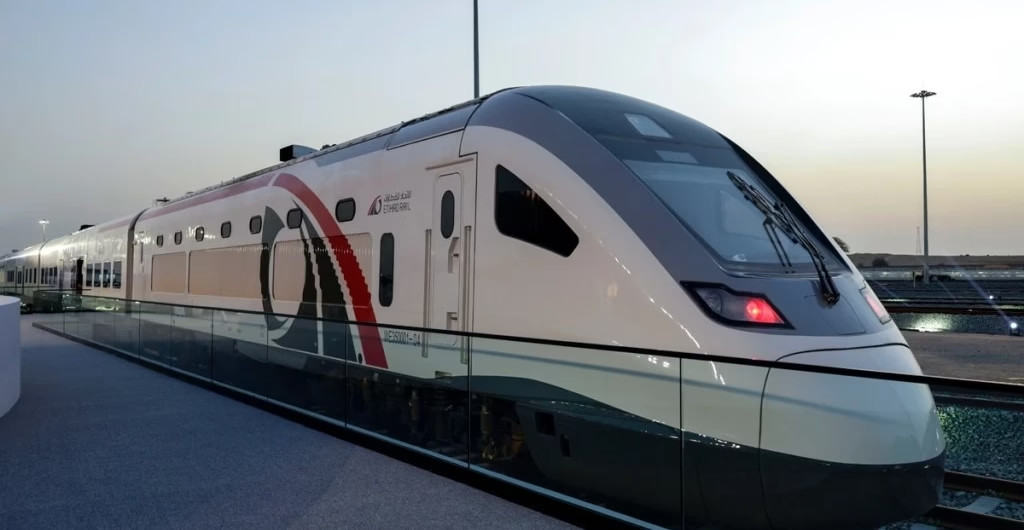Introduction to Etihad Rail
The United Arab Emirates (UAE) has always been a pioneer in innovation and infrastructure development, and Etihad Rail is a testament to this vision.
As the UAE’s national railway network, Etihad Rail is set to transform the country’s logistics and passenger transport sectors, fostering economic growth, sustainability, and seamless connectivity across the Emirates and beyond.
Spanning approximately 1,200 kilometers upon completion, Etihad Rail will link key cities, industrial hubs, and ports, drastically reducing travel time and transportation costs.
This ambitious project not only strengthens the UAE’s position as a global trade and logistics leader but also supports the nation’s sustainability goals by offering an efficient, eco-friendly alternative to road transport.
In this blog, we’ll explore the history, progress, benefits, and future prospects of Etihad Rail, showcasing how this monumental infrastructure project is reshaping the future of transportation in the UAE.

From Vision to Reality: How Etihad Rail Is Reshaping the UAE’s Future
The UAE has never shied away from ambitious infrastructure projects, but Etihad Rail stands out as a game-changer—one backed by hard numbers, strategic foresight, and a commitment to sustainable progress. Let’s dive into the origins, milestones, and quantifiable impact of this transformative national railway.
The Birth of a National Rail Network (2009–2013)
Etihad Rail was launched in 2009 under the directive of HH Sheikh Mohammed bin Rashid Al Maktoum, UAE Vice President and Ruler of Dubai, who emphasized:
“This project is not just about trains—it’s about connecting our economy, protecting our environment, and uniting our nation.”
The first phase (2016) proved the concept with:
- 264 km of track linking Shah, Habshan, and Ruwais.
- 7 million tons of sulphur transported annually, replacing 1 million truck trips per year—cutting CO₂ emissions by 80% for the same cargo volume.
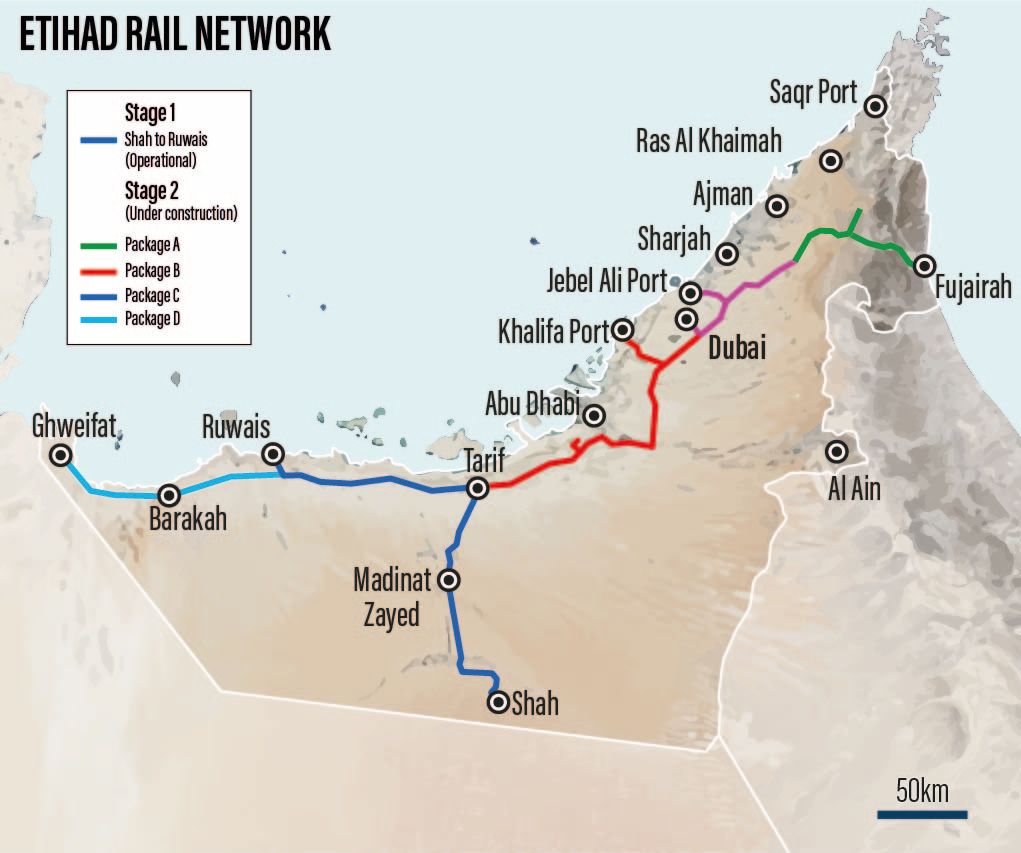
Phase Two: A Logistics Powerhouse (2016–2023)
By 2023, Etihad Rail completed its 1,200 km mainline, with Phase Two delivering staggering efficiencies:
- Freight capacity: Up to 60 million tons annually (equal to removing 5.6 million truck trips from roads by 2030).
- Port connections: Links to Khalifa Port, Jebel Ali, and Fujairah, boosting trade speed by 30–40% for key imports/exports.
- Emissions reduction: Rail freight produces 70–80% less CO₂ per ton than trucks—aligning with the UAE’s Net Zero 2050 goal.

Passenger Rail: Fast-Tracking the Future (2025 Onward)
The upcoming passenger service will redefine mobility:
- Abu Dhabi to Dubai in 50 mins (vs. ~90 mins by car).
- 50+ stations planned, serving 11.5 million passengers annually by 2030.
- GCC connectivity: Future links to Saudi Arabia (via Ghuweifat) and Oman (via Al Ain) will unlock regional tourism and trade.
Why the Numbers Matter
Etihad Rail isn’t just infrastructure—it’s an economic and environmental imperative:
- $54 billion – Projected contribution to UAE GDP by 2030 (via trade efficiency and job creation).
- 21 million tons – Annual CO₂ reduction once fully operational (equal to removing 3.2 million cars from roads).
- 400,000+ jobs – Expected to be created directly and indirectly.
As HH Sheikh Theyab bin Mohamed bin Zayed Al Nahyan, Chairman of Etihad Rail, stated:
“This railway is the artery of our nation’s sustainable development, moving not just goods and people, but also prosperity.”
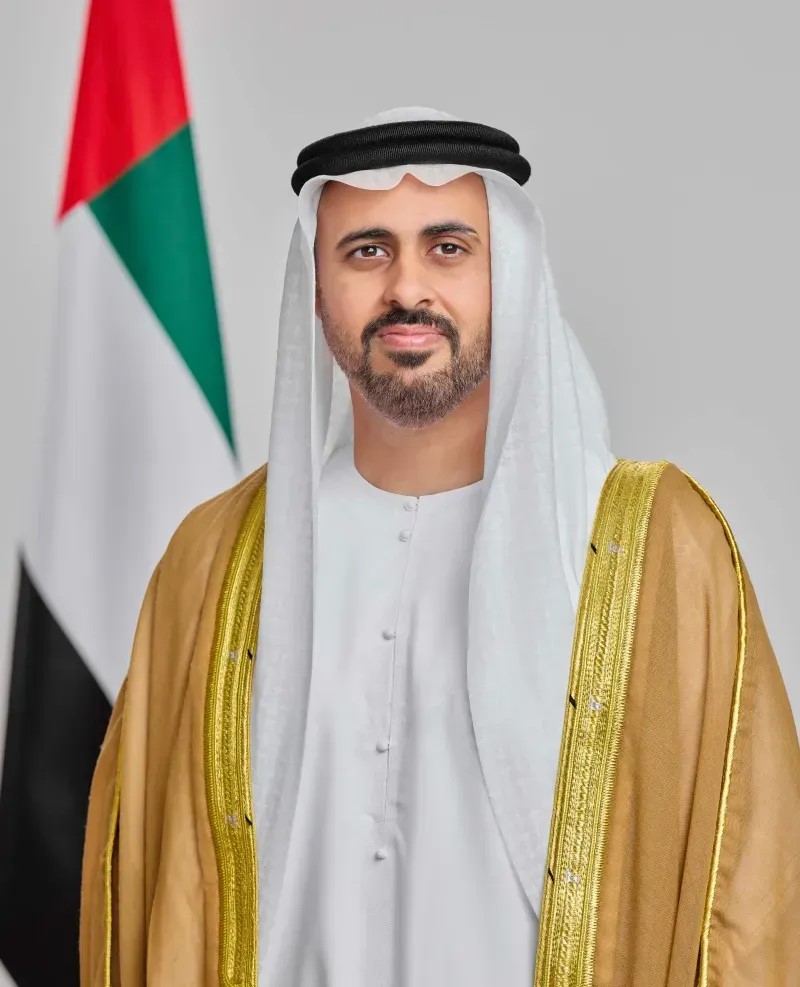
Planned Routes & Major Stations
Phase 1: Initial Network (2026 Launch)
The first phase will connect 11 major cities and regions, with trains running at speeds up to 200 km/h.
Main Intercity Routes:
- Abu Dhabi ⇨ Dubai
- Travel time: 50 minutes
- Major stations:
- Abu Dhabi Central (Downtown, near ADNEC)
- Khalifa City (near Yas Island & Airport)
- Dubai Maritime City (Port Rashid area)
- Dubai International Financial Centre (DIFC)
- Dubai ⇨ Sharjah ⇨ Ras Al Khaimah
- Travel time:
- Dubai to Sharjah: 15-20 minutes
- Dubai to RAK: 45 minutes
- Major stations:
- Sharjah City (near Al Jubail Bus Station)
- Al Dhaid (central Sharjah)
- Ras Al Khaimah Downtown
- Travel time:
- Dubai ⇨ Fujairah (via Sharjah & Khor Fakkan)
- Travel time: Under 50 minutes
- Major stations:
- Fujairah City Centre
- Khor Fakkan (East Coast)
- Abu Dhabi ⇨ Al Ain (Future GCC Link to Oman)
- Travel time: ~50 minutes
- Major station: Al Ain Central
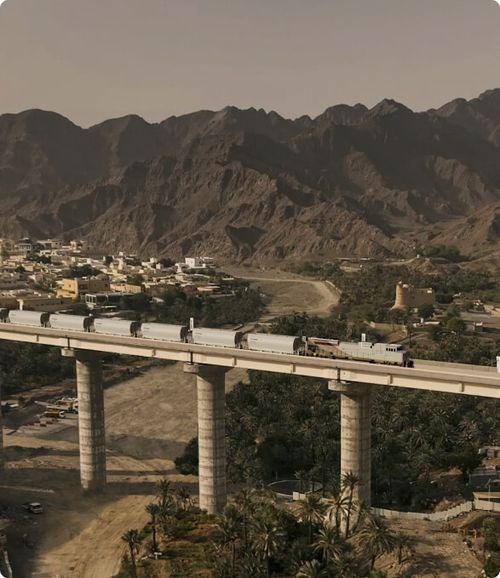
Future Expansions (Post-2026)
- GCC Connectivity
- UAE ⇨ Saudi Arabia (Ghuweifat Border)
- Part of the Gulf Railway Project, linking to Riyadh and Dammam.
- UAE ⇨ Oman (Al Ain ⇨ Sohar & Muscat)
- Expected travel time: Al Ain to Sohar in ~1 hour.
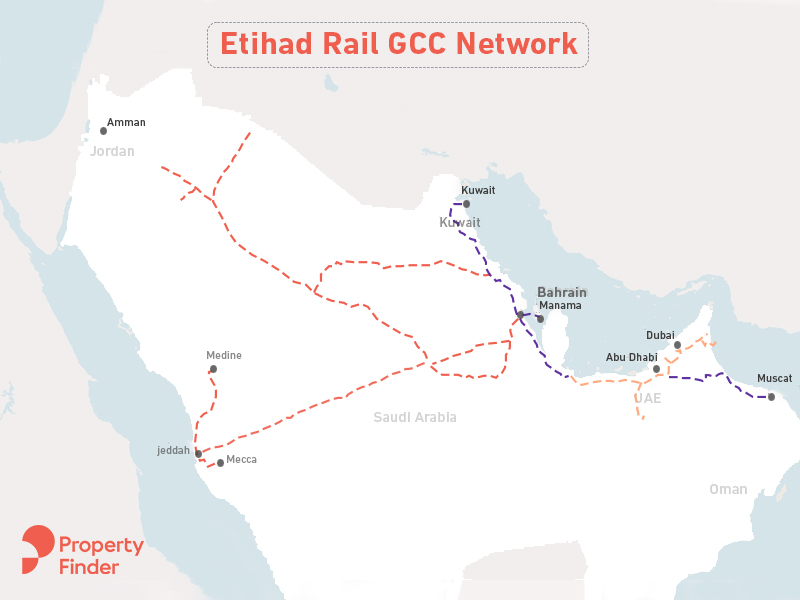
- Northern Emirates Extension
- Ras Al Khaimah ⇨ Umm Al Quwain ⇨ Ajman
- Enhancing connectivity for Northern Emirates residents.
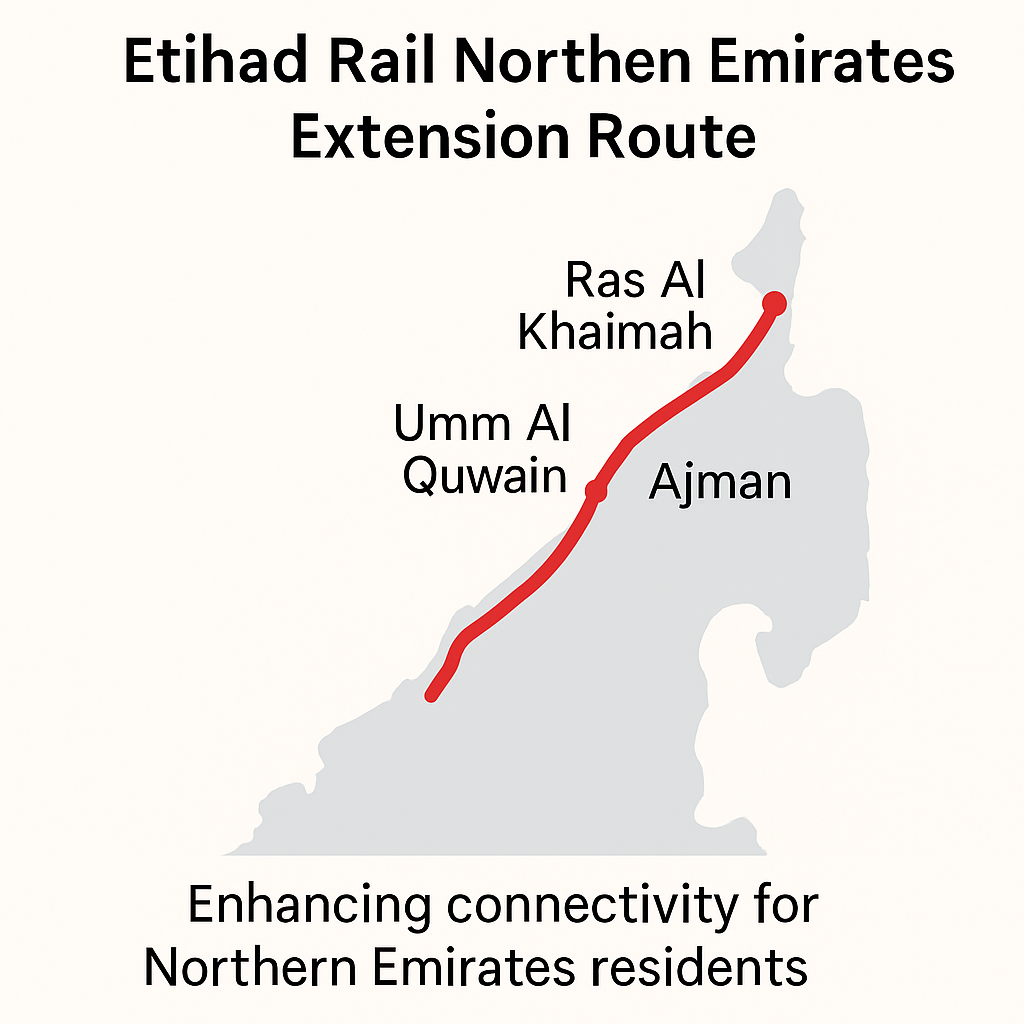
- Urban & Tourist Routes
- Expo City Dubai ⇨ Abu Dhabi (Direct link for major events)
- Fujairah ⇨ Dibba (Musandam access for tourism)
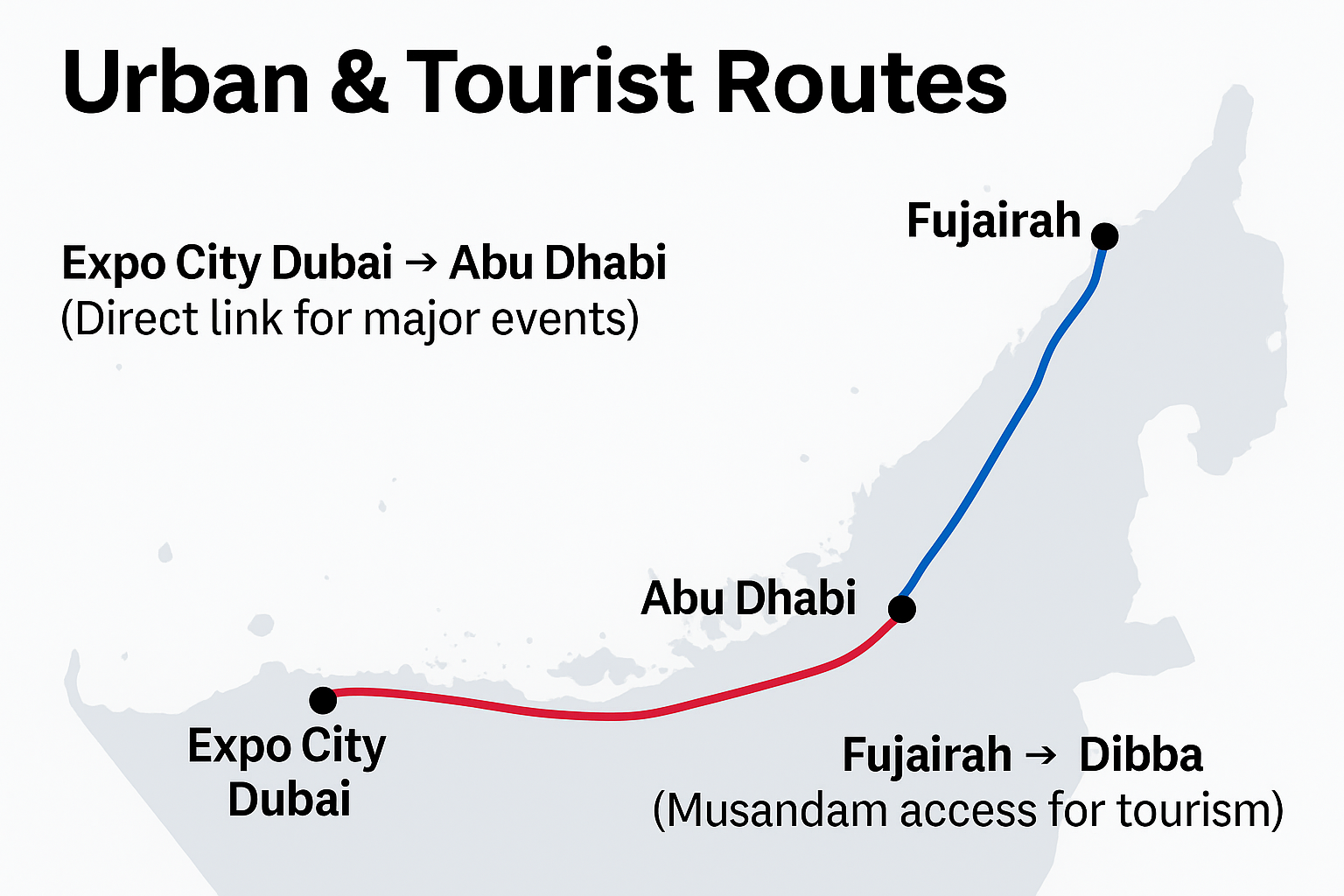
Travel Time & Passenger Amenities
Revolutionizing UAE Travel Times
| Route | By Car (2024) | Etihad Rail (2026) | Time Saved |
| Abu Dhabi ↔ Dubai | ~90-120 mins | 50 mins | 40-70 mins |
| Dubai ↔ Fujairah | ~120 mins | <50 mins | 70+ mins |
| Dubai ↔ RAK | ~60-90 mins | 45 mins | 15-45 mins |
| Abu Dhabi ↔ Al Ain | ~90 mins | 50 mins | 40 mins |
Premium Passenger Amenities
- Three Class Options
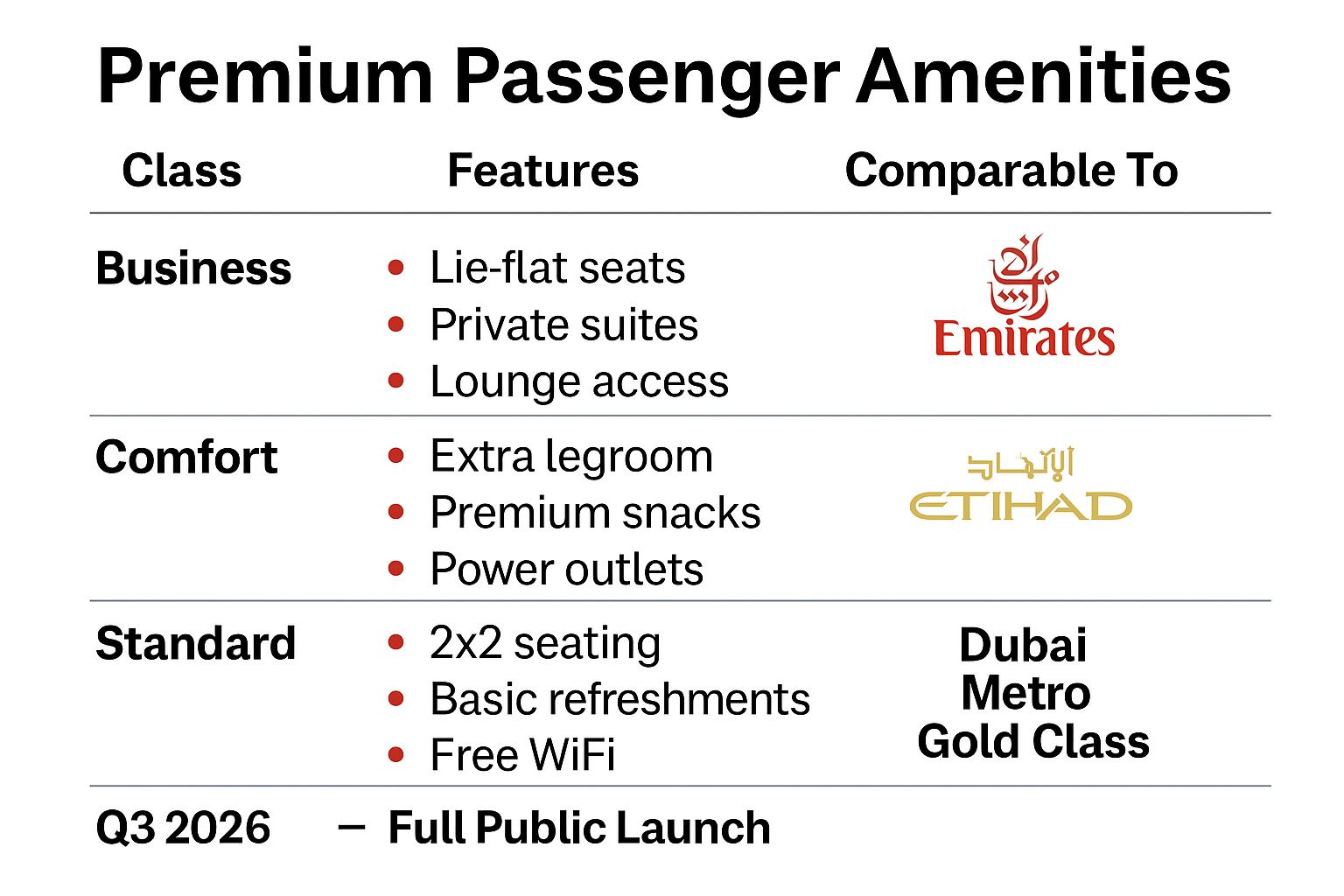
- Smart Travel Features
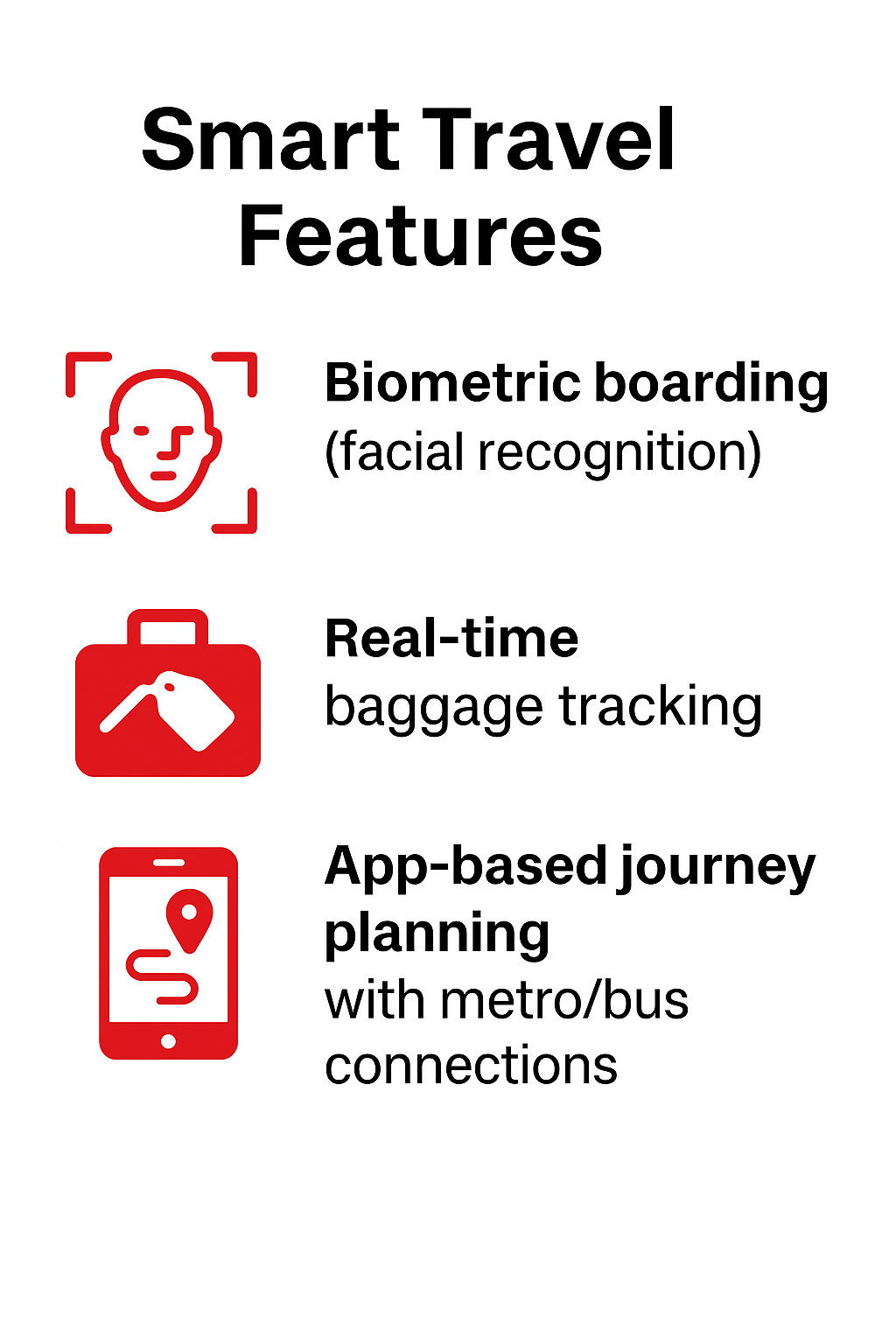
- Accessibility & Family Services
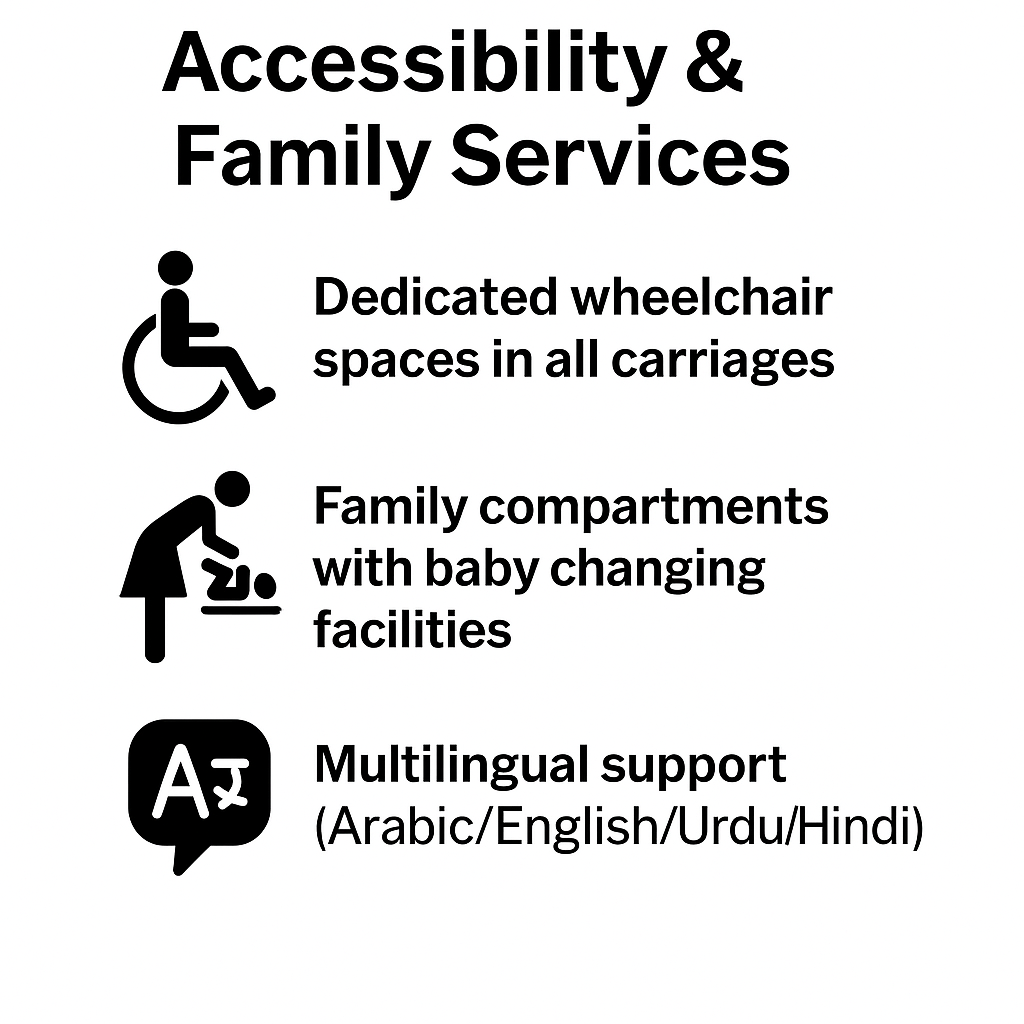
- Dining & Retail
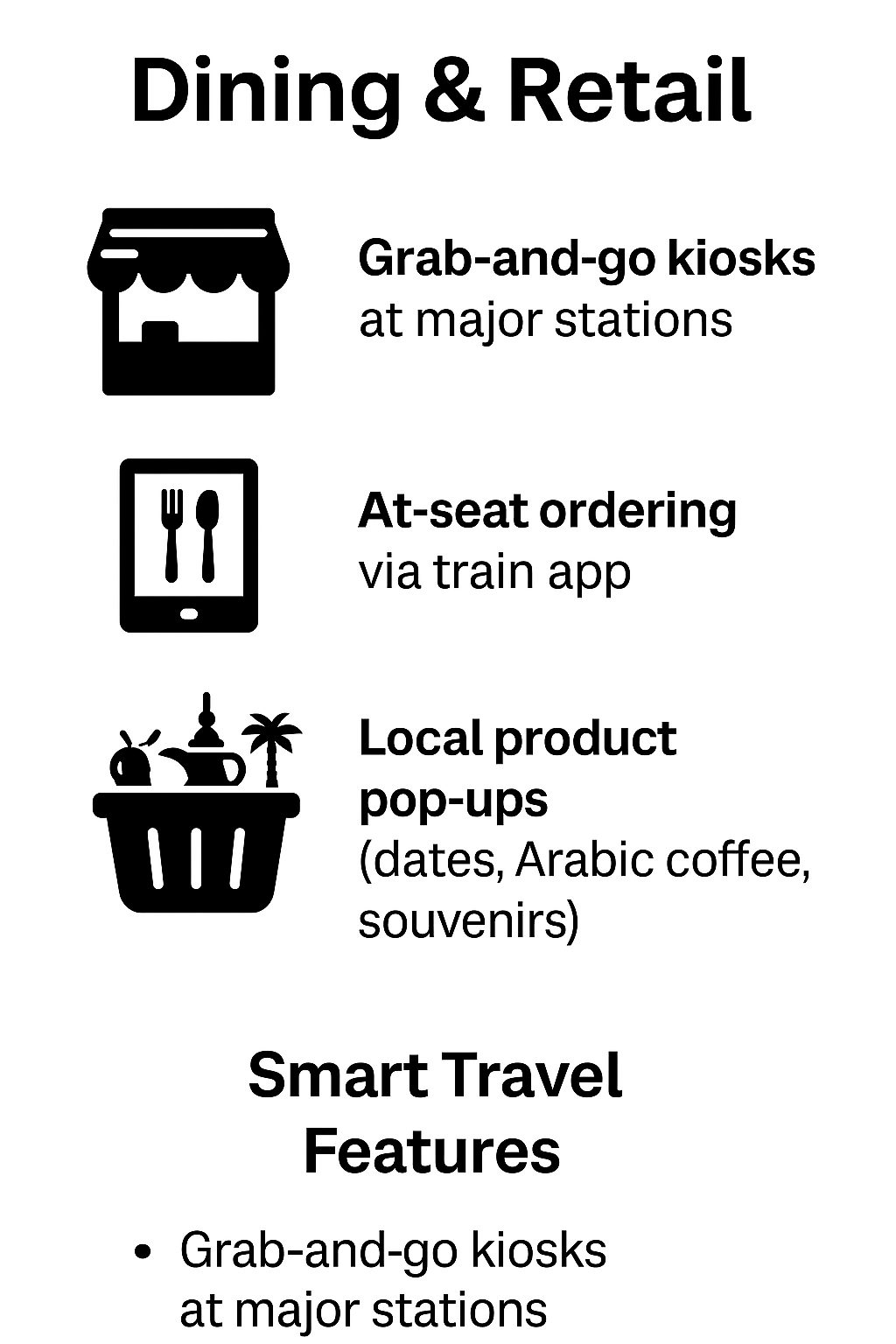
Sustainable Travel Perks
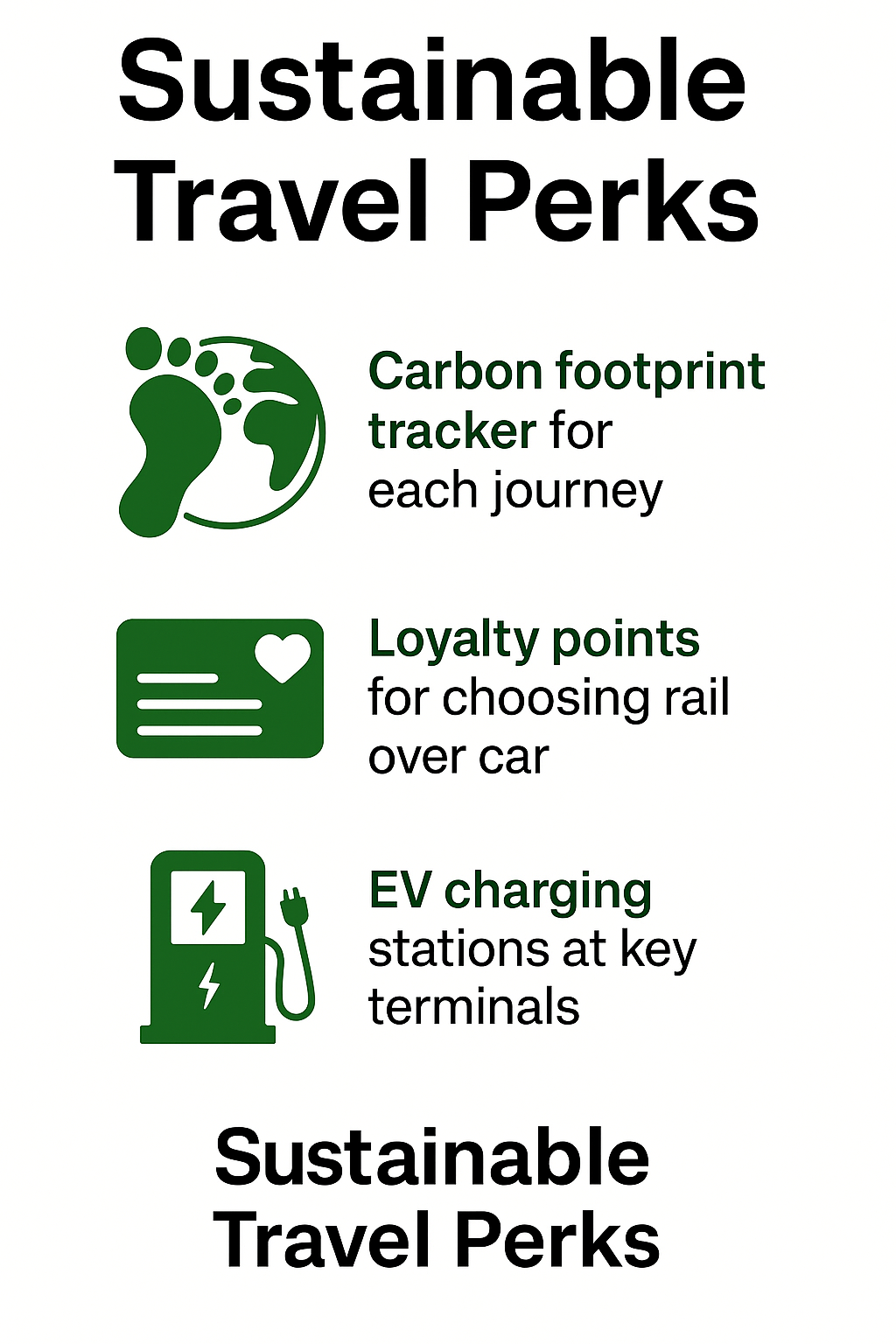
Launch Timeline & Key Milestones
The Road to 2026: Critical Milestones
2009 – The Vision Begins
- UAE federal decree establishes Union Railway (later rebranded as Etihad Rail)
- Initial feasibility studies for a national freight and passenger network
2013 – Freight Operations Start (Phase 1)
- First 264 km freight line opens (Shah-Habshan-Ruwais)
- Transports 7M tons/year of sulphur, replacing 1M truck trips annually
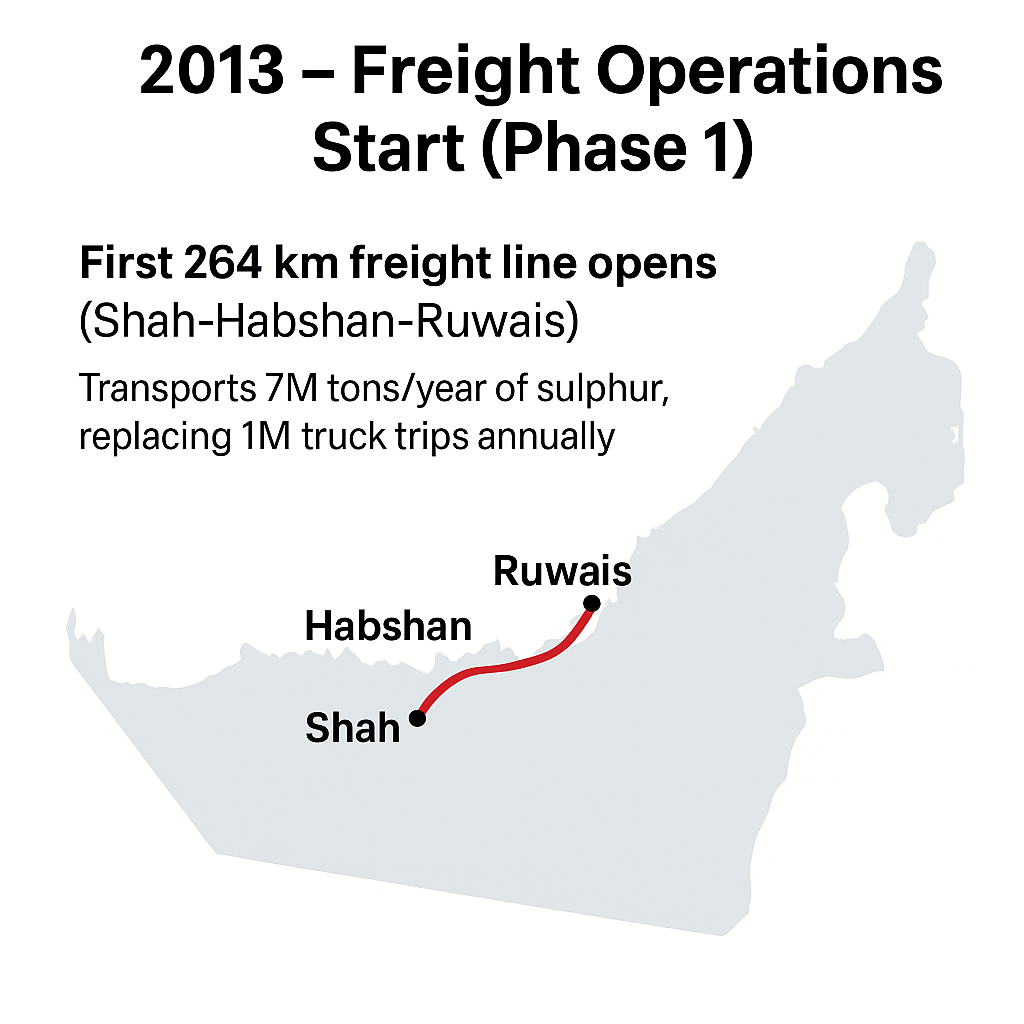
2016-2021 – Network Expansion (Phase 2)
- 605 km added, connecting:
- Ghuweifat (Saudi border) ↔ Fujairah
- Khalifa Port ↔ Jebel Ali
- 2021: Track-laying completed at 70% of total network
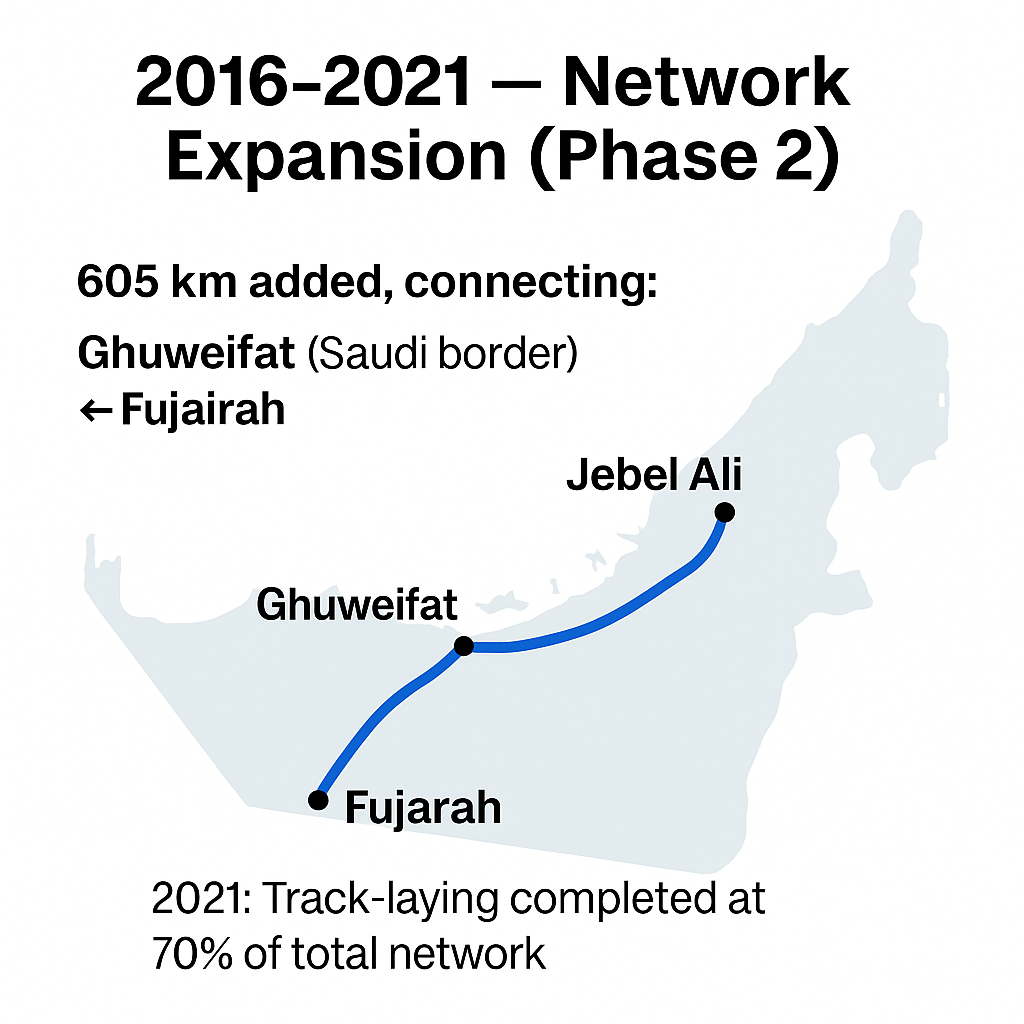
2023 – Full Mainline Completion
- Entire 1,200 km network finalized
- First passenger train tests begin on Abu Dhabi-Dubai route
2024-2025 – Final Testing & Certification
- Speed trials (200+ km/h achieved)
- Station construction completed at 11 major hubs
- Safety certifications from UAE and international regulators
Q1 2026 – Soft Launch (Limited Service)
- Abu Dhabi ↔ Dubai route opens to government/invite-only passengers
- Public preview events at major stations
Q3 2026 – Full Public Launch
- All Phase 1 passenger routes operational:
- Abu Dhabi ↔ Dubai ↔ Sharjah ↔ RAK
- Dubai ↔ Fujairah
- 50+ daily departures at peak times
2027 & Beyond: What’s Next?
- GCC Integration:
- 2027: UAE-Saudi Arabia link (Ghuweifat extension)
- 2028: UAE-Oman route (Al Ain ↔ Sohar)
- Night Trains: Overnight sleeper cabins to Gulf destinations
- Hyperloop Connections: Potential integration with Dubai-Abu Dhabi hyperloop
How It Will Transform UAE Travel
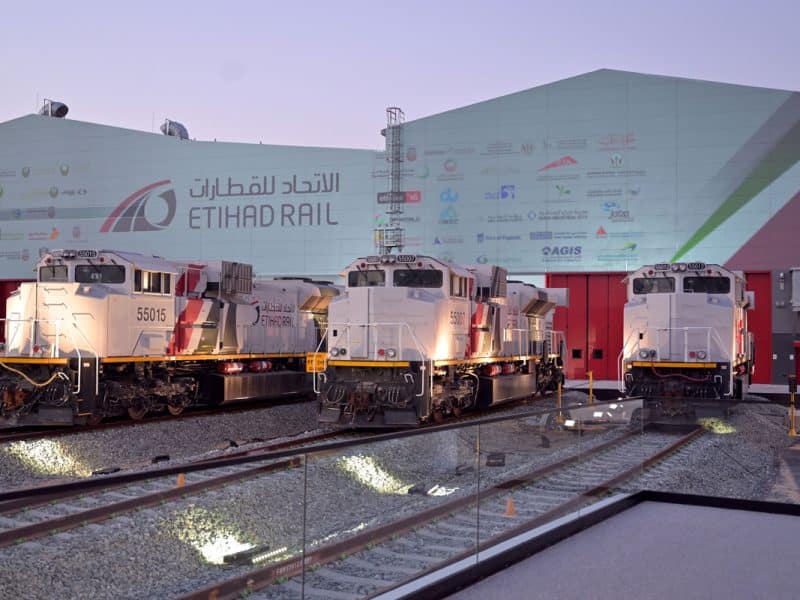
5 Ways Etihad Rail Will Revolutionize UAE Travel
- The End of Traffic Headaches
- 50-minute Abu Dhabi-Dubai trips eliminate rush-hour stress
- 30% fewer cars on key highways (E11, E311) by 2030
- No more parking hassles in business districts like DIFC/ADGM
- A Tourism Game-Changer
- Fujairah beaches become a day-trip from Dubai
- Sharjah’s cultural sites (Al Noor Island, Mleiha) more accessible
- GCC-wide rail passes expected by 2028 (UAE-Oman-Saudi trips)
- The Greener Way to Travel
- 1 train = 200+ cars off the road (per trip)
- 70% lower emissions than equivalent car journeys
- Solar-powered stations at major hubs
- Supercharged Business Connectivity
- Dedicated work pods with WiFi for executive travelers
- Same-day meetings across multiple emirates
- Logistics cost savings for companies using rail freight
- A New Urban Lifestyle
- Property demand shifts to rail-connected areas (Al Falah, Al Dhaid)
- Last-mile solutions – e-scooter rentals at stations
- Weekend getaways made effortless (Dubai → RAK in 45 mins)
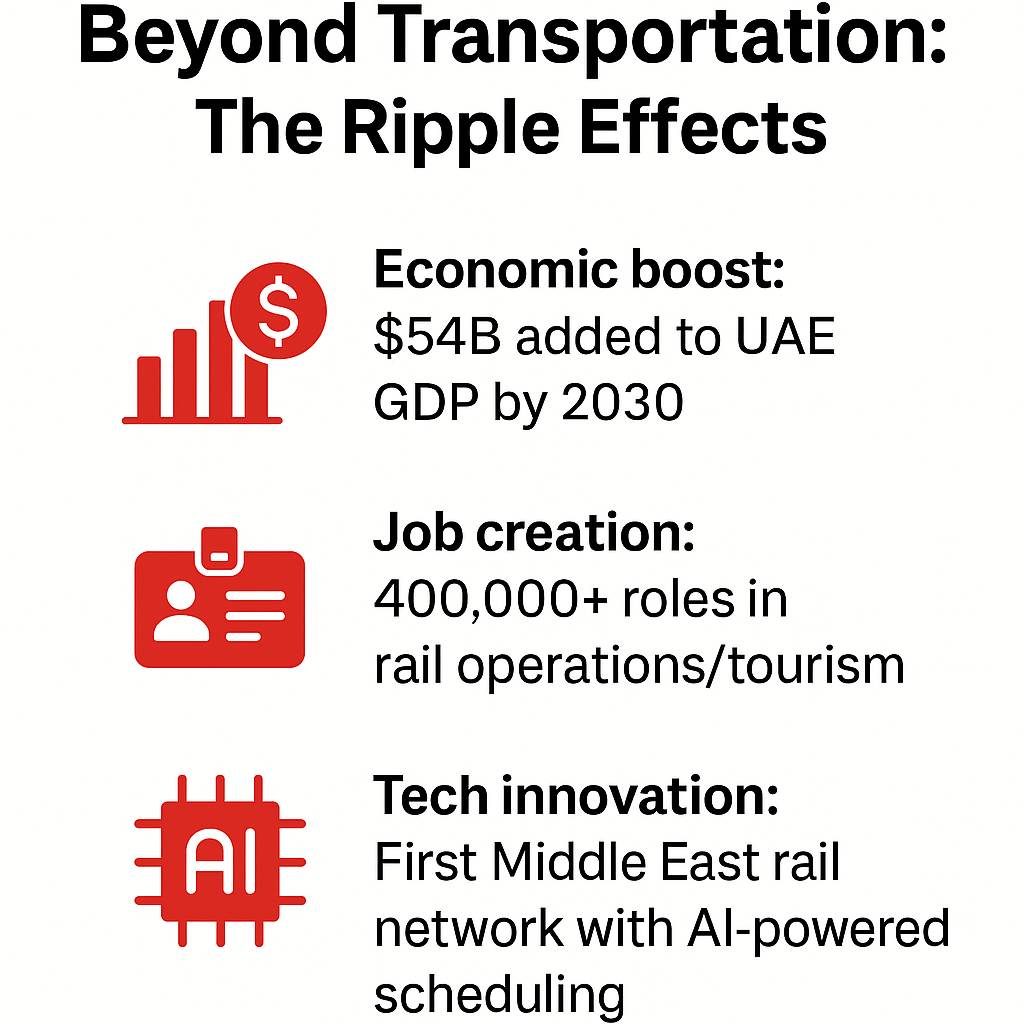
Conclusion: The Future on Tracks
Etihad Rail’s passenger service marks more than just a new way to travel—it’s the start of a smarter, greener, and more connected UAE.
By 2030, taking the train will be as natural as hopping in a car is today, with benefits that extend far beyond shortened commute times.

For residents, it means reclaiming hours lost in traffic.
For tourists, it unlocks seamless exploration. For businesses, it delivers unprecedented efficiency. And for the nation, it’s a bold step toward sustainable growth that other GCC countries are already racing to emulate.

